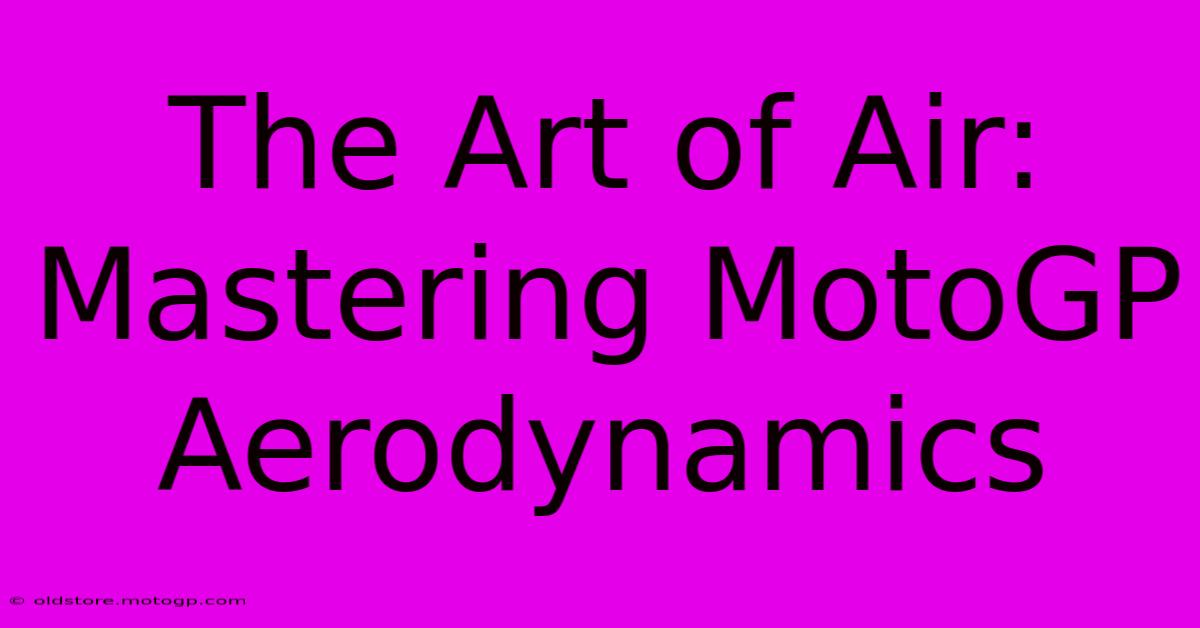The Art Of Air: Mastering MotoGP Aerodynamics

Table of Contents
The Art of Air: Mastering MotoGP Aerodynamics
MotoGP, the pinnacle of motorcycle racing, isn't just about horsepower and rider skill. It's a relentless pursuit of aerodynamic perfection, a battle fought in the slipstream, a dance with the wind. Understanding and mastering aerodynamics is crucial for achieving victory at the highest level. This article delves into the intricate world of MotoGP aerodynamics, exploring the science behind the wings, winglets, and fairings that shape the performance of these incredible machines.
The Science of Speed: Understanding Aerodynamic Principles
At speeds exceeding 200 mph, aerodynamic forces become paramount. The air rushing past a MotoGP bike creates drag, slowing it down, and lift, potentially causing instability. The goal of MotoGP aerodynamics is to minimize drag while simultaneously managing lift and generating downforce.
Drag Reduction: The Key to Higher Speeds
Drag is the resistance a vehicle experiences as it moves through the air. Minimizing drag is crucial for achieving higher top speeds and improving acceleration. MotoGP teams employ sophisticated Computational Fluid Dynamics (CFD) simulations and wind tunnel testing to refine the shape of fairings and other components, streamlining the bike to reduce drag. Even small changes can significantly impact performance.
Downforce Generation: Sticking to the Track
Unlike cars, MotoGP bikes don't rely solely on tires for grip. Aerodynamic downforce plays a vital role in keeping the bike planted to the track, particularly during cornering and braking. This downforce is generated by strategically placed aerodynamic devices such as wings and winglets. These elements generate a downward force, increasing traction and allowing riders to push harder into corners without losing control.
Managing Lift: Preventing Wheelies and High-Sided Accidents
Lift is the upward force generated by air pressure. While downforce is beneficial, excessive lift can be dangerous, causing wheelies at acceleration and potentially leading to high-sided accidents. Careful aerodynamic design is crucial to manage lift, ensuring the bike remains stable throughout varying speeds and maneuvers.
The Evolution of MotoGP Aerodynamics: From Fairings to Wings
The history of MotoGP aerodynamics is a fascinating journey of continuous innovation. Early MotoGP bikes had basic fairings primarily for rider protection. However, as speeds increased, the need for more sophisticated aerodynamic solutions became apparent.
The Rise of Winglets and Wings
The introduction of winglets and wings marked a significant turning point. These aerodynamic devices, inspired by Formula 1 technology, dramatically improved downforce generation. Their design, however, is constantly evolving, with teams experimenting with various shapes and configurations to optimize performance. The placement and angle of these aerodynamic aids are crucial to maximize their effectiveness and avoid negative consequences like increased drag or turbulence.
The Ongoing Arms Race: Constant Development and Refinement
The quest for aerodynamic advantage is an ongoing arms race. Teams constantly refine existing designs and explore new technologies, pushing the boundaries of what's possible. Materials science also plays a significant role, with lighter and stronger materials enabling more complex and effective aerodynamic designs. This constant evolution ensures that MotoGP bikes remain at the forefront of aerodynamic innovation.
The Human Factor: Rider Input and Adaptation
Aerodynamics isn't just about the machine; it's deeply intertwined with the rider. The rider's posture, body position, and riding style all influence how the bike interacts with the air. Therefore, close collaboration between engineers and riders is essential to optimize aerodynamic performance. Riders provide invaluable feedback, informing the development and refinement of aerodynamic components.
Conclusion: The Future of Aerodynamics in MotoGP
The art of air in MotoGP is a complex and ever-evolving field. From meticulous CFD simulations to on-track testing, every aspect of aerodynamic design is crucial to success. As technology continues to advance, we can expect further innovations in aerodynamic design, leading to even faster, more stable, and more thrilling races in the future. The battle for aerodynamic supremacy in MotoGP is far from over; it's a continuous push for perfection, a constant dance with the wind that defines the sport's cutting edge.

Thank you for visiting our website wich cover about The Art Of Air: Mastering MotoGP Aerodynamics. We hope the information provided has been useful to you. Feel free to contact us if you have any questions or need further assistance. See you next time and dont miss to bookmark.
Featured Posts
-
The Ultimate Guide To Free Moto Gp Live Streams
Feb 19, 2025
-
The Easiest Way To Park At F1 Austin
Feb 19, 2025
-
Yamaha V4 The Power To Explore
Feb 19, 2025
-
Amplify Your F1 Weekend The Austin Concert
Feb 19, 2025
-
Moto2 Specs The Heart And Soul Of A Racing Machine
Feb 19, 2025
